Habitat Enhancement
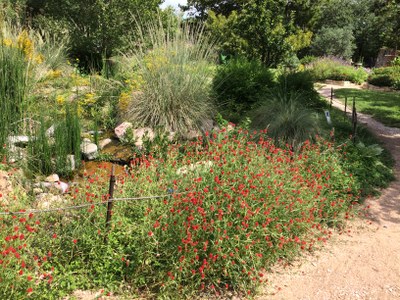 Native Plants for Birds
Native Plants for Birds
Habitat Management Practices
Prescribed Fire
No Mow Areas
Habitat Connectivity
Wetlands for Flood Mitigation
Retaining Dead Wood
Providing Food, Water, & Shelter
Bird Feeders
Water for Birds
Nest Boxes
Native Plants for Birds
Native birds rely on native plants. Native plants in natural settings, “wild” areas of parks, and non-landscaped areas provide the food and shelter that birds need to thrive. Non-native plants change the ecology of our parks and wild areas, and usually provide much lower quality habitat for our migrating and breeding birds. When used in landscaped areas, native plants attract insects that attract pollinators and food for birds through seeds, fruits, nuts, and nectar. They also provide food indirectly by supporting healthy insect populations. Our native birds and insects are adapted to survive and thrive with native plants. Exotic ornamental plants often provide little or no benefit to wildlife. Native plants make beautiful additions to our communities and typically require less water and maintenance than non-natives. Learn more about how to use native plants in landscaping at the links below.
- Audubon's Plants for Birds
- Audubon's Native Plants Database
- Lady Bird Johnson Wildflower Center's Guide to Native Plant Gardening
- Lady Bird Johnson Wildflower Center's Plant Lists and Collections
- TPWD's Wildscapes Program
Habitat Management Practices
Managing habitat for birds is the best way to help birds in our communities. The list below is not at all comprehensive but helps to explain some management techniques that may not be commonly understood. Not all habitat management techniques are appropriate in all areas. For more specific recommendations in your areas, seek guidance from biologists or other professionals.
Prescribed Fire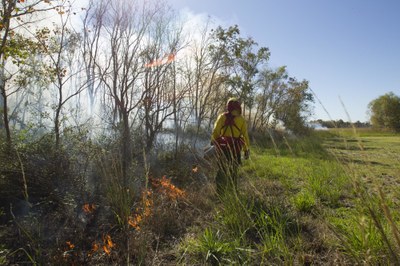
Historically, many Texas landscapes experienced periodic, naturally-occurring wildfires. These fires played an important role in shaping our state’s ecosystems. Today, fire still has a critical role to play in the natural areas in our communities. Prescribed fires are carefully planned and controlled burns that provide numerous benefits including:
- Stimulates new plant growth
- Increases plant species diversity
- Prevents encroachment by woody and invasive plant species
- Improves forage opportunities for birds and other wildlife
- Increases seed germination
- Increases nutrient cycling
- Reduces fuel loads, lowering the risk of catastrophic fires
Conducting prescribed burns in urban areas can seem like a challenge, but with careful planning, a team of trained professionals, and public education it can be a substantial benefit to the entire community. More information about prescribed fire can be found here.
No Mow Areas
“No Mow” areas are designated spaces that are on a reduced mowing schedule to promote native plant growth. Allowing native plants to grow in these areas provides food and shelter for birds and other wildlife, offers the aesthetic benefit of wildflowers, promotes water retention in the soil, and reduces maintenance costs. Vegetation removal should be planned and scheduled with the specific needs of the location in mind and should only take place after winter, as the seeds on these plants provide forage and shelter for wintering bird.
Habitat Connectivity
Habitat connectivity, or a functional network of connected habitats, is essential in maintaining biodiversity across a landscape. As land becomes more and more fragmented, connectivity between species and ecological communities is lost. If possible, this connectivity should be protected while habitats are still intact, through permanent conservation and adaptive management techniques. Avoiding further fragmentation of habitats is ideal; development and infrastructure projects should be placed where they are least likely to disrupt habitat connectivity. Additionally, communities should minimize and mediate the effects of physical barriers to movement for bird species. You can find more information about planning for habitat connectivity here:
Wetlands for Flood Mitigation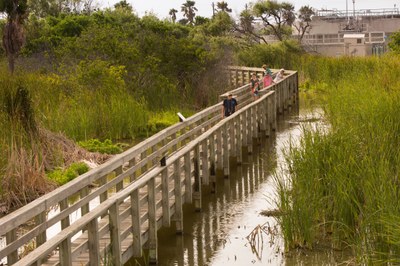
Wetlands are unique features in the landscape that represent the transition zone between upland habitats and water. Wetlands perform critical ecosystem services like improving water quality, reducing water velocity, holding water in place, sediment retention, and nutrient cycling. In addition, wetlands support many unique bird species that rely on aquatic environments for survival. Incorporating natural wetlands into a community’s flood control planning will benefit both birds and people.
More information:
- Wetland Functions and Values
- US Environmental Protection Agency: Wetlands Protection and Restoration
Retaining Dead Wood
Trees benefit birds in countless ways. In fact, even dead trees are critically important for many bird species. Standing dead trees are known as snags and they benefit birds by providing food and shelter. Snags may appear lifeless, but take a closer look and you will find a wide variety of invertebrates, which makes snags a great place for many birds to find a snack. Several species of birds will also create or use existing cavities in snags to nest. Cavity nesting species like Eastern Screech- Owls, Carolina Chickadees, Downy Woodpeckers, and Eastern Bluebirds rely on snags to raise their young. If snags pose no threat to people or property, they should be left standing so that birds can continue to benefit.
Read more about the Value of Dead and Down Wood (snags).
Providing Food, Water, & Shelter
These three elements are vital to the creation of any wildlife habitat, including habitat for birds. Year-round, birds need food to sustain them, water to drink, and shelter to live and raise their young in. Native plants, local water sources, and layers of vegetation for shelter are ideal and serve these roles in nature, but artificial feeders, water sources, and nest boxes can also provide these necessary resources for birds.
Bird Feeders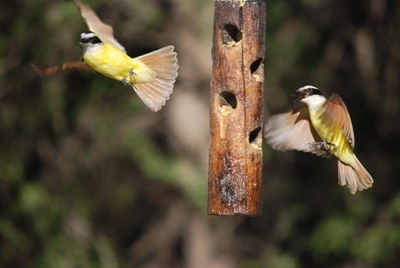
The best way to provide food for birds is to plant native plants, but bird feeders can also be an important tool. Bird feeders attract birds and often provide enjoyable viewing experiences. There are many different types of feeders and food to choose from, so it is important to consider which types of birds are present in your area so you can target the species you want to attract. Bird feeders require regular cleaning maintenance to ensure that the food remains safe for the birds and that undesirable species (i.e. rodents) are not attracted to the feeder.
Bird feeder information:
- Audubon Guide to Bird Feeders
- Audubon Guide to Birdseed
- Audubon Guide to Bird Feeding
- Audubon Guide to Feeding Hummingbirds
Water for Birds
In our hot and dry Texas climate, water is often a critical resource for birds. Ponds, bubbling rocks, and shallow basins are a few examples of ways to provide water for birds. Water features should be relatively shallow and mimic nature as closely as possible. The structures should be cleaned regularly to prevent algae growth and the establishment of mosquitoes.
How to provide water for birds:
- Great Backyard Bird Count: Providing Water for Birds
- Four Ways to Provide Water for Birds
- Houston Audubon's Make a Splash for Birds Video
Nest Boxes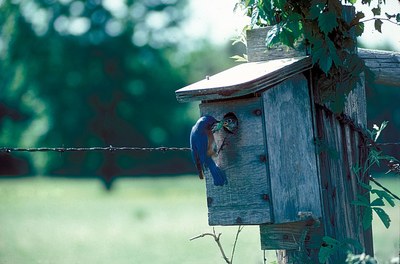
From Purple Martins to screech-owls, there are several species of cavity nesting birds in Texas. While a handful of these species will excavate a new cavity in a dead tree, the majority rely on existing natural or man-made cavities. Installing nest boxes is a great way to provide an important resource to these birds. Nest boxes come in a wide variety of shapes and sizes, so pick a nest box that is appropriate for your target species. It is important to maintain nest boxes properly and prevent invasive species and competitors from using them.
Nest box plans: